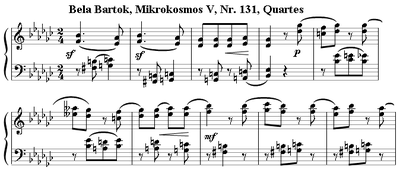Mikrokosmos (Bartók)
Béla Bartók's Mikrokosmos (in Hungarian, Mikrokozmosz) Sz. 107, BB 105 consists of 153 progressive piano pieces in six volumes written between 1926 and 1939. The individual pieces progress from very easy and simple beginner études to very difficult advanced technical displays, and are used in modern piano lessons and education. In total, according to Bartók, the piece "appears as a synthesis of all the musical and technical problems which were treated and in some cases only partially solved in the previous piano works." Volumes one and two are dedicated to his son Péter, while volumes five and six are intended as professionally performable concert pieces.[1] Bartók also indicated that these pieces could also be played on other instruments; Huguette Dreyfus for example has recorded pieces from Books 3 through 6 on the harpsichord.

In 1940, shortly before they emigrated to the United States, he arranged seven of the pieces for two pianos, to provide additional repertoire for himself and his wife Ditta Pásztory-Bartók to play.
Volumes
All of the six volumes progress in difficulty, namely:
- Volumes I and II: Pieces 1–36 and 37–66, beginner level
- Volumes III and IV: Pieces 67–96 and 97–121, moderate to advanced level
- Volumes V and VI: 122–139 and 140–153, professional level
The list of pieces is as follows:
|
|
|
|
|
|
Music
The opening (mm. 1–76) of "Boating" (V, 125) is typical of the modernist compositional techniques used in the later volumes, featuring the bimodal use of the pentatonic collection on E♭ in the right hand and either G mixolydian or dorian collections in the left:[2]
Volume VI contains the "Six Dances In Bulgarian Rhythm", dedicated to the English pianist Harriet Cohen. Bulgarian folk music is characterized by additive rhythm, that is rhythm where the beats in each bar are of unequal length. For example, the first dance (148) is grouped into 4+2+3 quavers in each bar, and the final dance (153) is grouped into 3+3+2 quavers in each bar.
Pianists who have recorded all six volumes include György Sándor, Edith Farnadi, Homero Francesch, Zoltán Kocsis, Dezső Ránki, Jenő Jandó, Claude Helffer, and Georges Solchany. Bartók himself was the first to publicly perform pieces from Mikrokosmos, on February 9, 1937 in London.[3]
References
- Carpenter, Alexander AllMusic.com: Mikrokosmos, Retrieved 01:10, April 2, 2005 (UTC)
- Stein, Deborah (2005). "Introduction to Musical Ambiguity" in Engaging Music: Essays in Music Analysis, p.82–83. New York: Oxford University Press. ISBN 0-19-517010-5.
- Suchoff, Benjamin. Béla Bartók: A Celebration, p. 83 (Scarecrow Press, 2004).
External links
- Mikrokosmos (Bartók): Scores at the International Music Score Library Project (IMSLP)